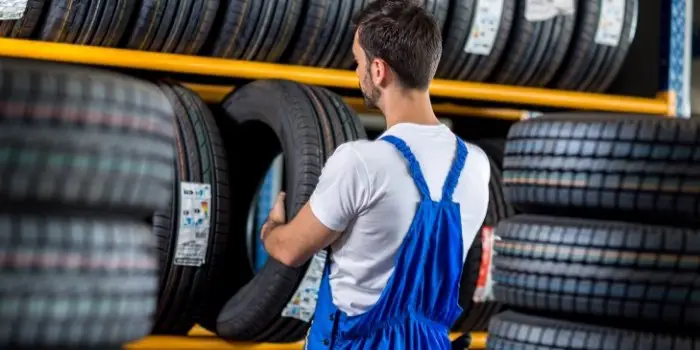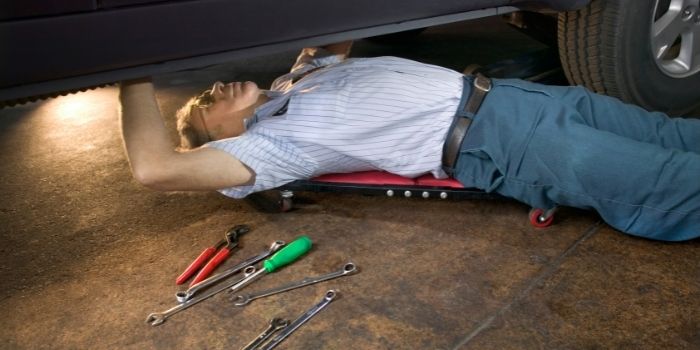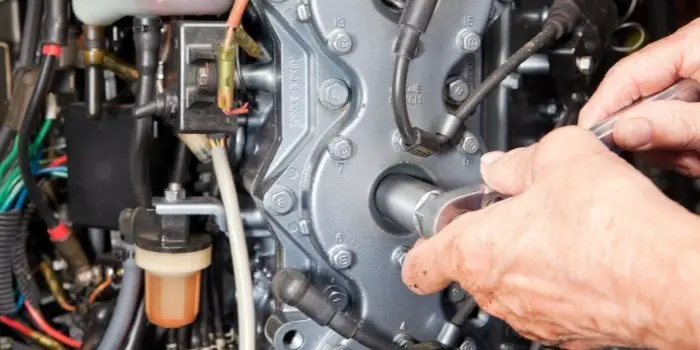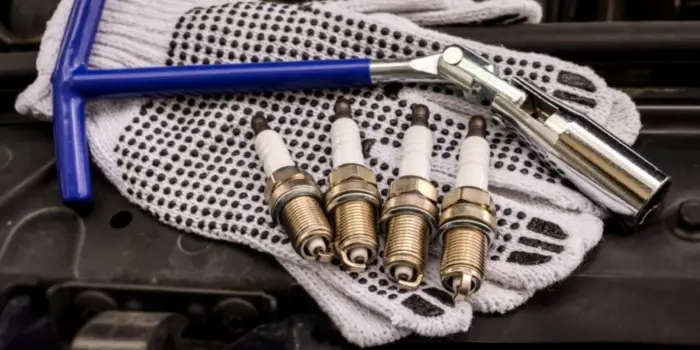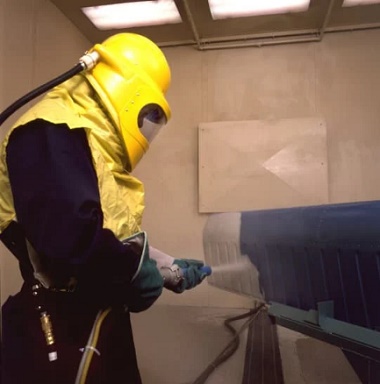
So, you want to remove the paint on your car?
And make sure that the old, rusty, bad finish of the car is properly taken off so you can again put a new, well-coated paint.
Correct?
Then you’ve come to the right place.
In short, plastic is regarded as the safest blasting media for removing car paint from surfaces such as metals, fiberglass, PVC, and others.
Although it’s widely used in industries including automotive, aviation, boating, home construction, electronics, etc., there are instances and surfaces where better blasting media materials can be utilized to get the job done.
Also, you will need to know how to safely use them.
In this article below, you’ll learn more about what is sandblasting and how to do proper paint removal, and get your car ready for a new, better finish so it looks as good as new.
So, without any delay, let’s begin:
What is Sandblasting?
Sandblasting, also known as abrasive blasting, is a process of removing rust, paint, or debris from a surface using compressed air before applying an industrial finish such as paint or powder coating.
Sandblasting produces the same sort of finish as hand sanding but in a more efficient manner.
It necessitates the use of specialized equipment such as a blast chamber, blast cabinet, and air compressor. The equipment utilized is determined by the approach that is most suited to the project at hand.
Despite its name, sand is not the principal material utilized in sandblasting. Because it tends to break down and convert to powder on contact, it is less enduring and effective.
Moreover, sand includes silica, which has been linked to significant respiratory problems among sandblasting workers.
And it is found to have a high moisture content, which might cause blasting equipment to fail prematurely.
Other substances, such as beads of glass or plastic, walnut shells, and even steel grit, are more suitable for sandblasting because they are considerably more effective than sand and do not get damaged easily.
How to Sandblast a Car and Its Parts?
While sandblasting is a process that should be dealt with professionally, if you know what you are doing and have all the things required – you can do it in a DIY way.
To get started, you will need to access the parts you desire to get sandblasted as this will affect your choice in choosing the right sand media.
Parts like door panels, for example, should be sandblasted with 36-grit silica sand. But if it’s an underbody part you can use a washed beach sand.
Once you have the sanding media ready at hand, follow these steps…
- Remove the part from the car you intend to blast
- Set the part outdoors, away from your garage or home, where you can dispose of the sand easily
- Load the blasting media (sand) into the sand blaster container, attach the sand blaster gun to the air hose and spray in short bursts to remove the paint or rust
Before sandblasting do not forget to set the PSI for your compressor at an appropriate level.
While spraying hold the gun about 8 to 12 inches from the car part and work quickly by moving the gun from side to side.
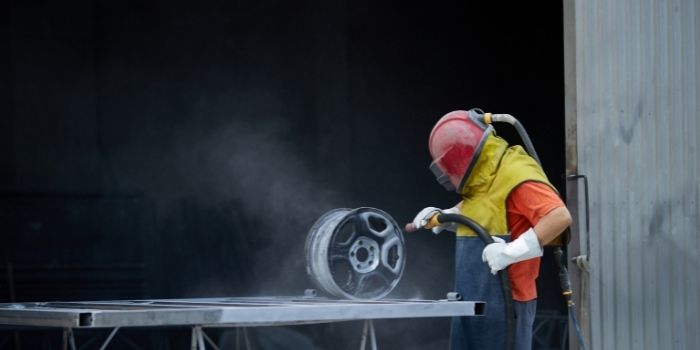
What Media to Use to Sandblast Paint Off Metal?
Plastic or glass beads, aluminum oxide, and ground-up walnut shells are the most widely utilized media for sandblasting a car and its parts like rims, frame, hood, roof, and others.
Given below are proper explanations of different media in car sandblasting and how they are used to get the best results:
1- Glass Beads
This is a softer and less aggressive media than steel shot or silicon carbide.
It is, nonetheless, a fantastic choice for circumstances requiring a soft, lit, and bright finish.
Another advantage of using glass beads is that they can also be reused many times over.
2- Aluminum Oxide
It is distinguished by its high hardness and strength.
It is utilized in a number of applications, such as anti-slip surfaces, industrial blasting media, and as a raw material in refractories.
And is intended for sand pressure blasting of practically any substratum, including steel, marble, granite, and glass.
Because of its capacity to extensively etch, it is used to prepare car surfaces before painting and coating.
3- Plastics
This media is a dry thermoset cleaning medium composed of pulverized urea, polyester, or acrylic.
Each differs and is available in a variety of sizes and hardness of the particles.
It is frequently regarded as the appropriate medium for mold cleaning, plastic component blasting, and applications where removal of the substrate material is banned.
4- Silicon Carbide
It is the most durable abrasive blasting substance on the market, making it the finest choice for the most difficult surface finishing tasks.
It is available in a variety of hues and purity levels.
Glass etching, lapping, polishing, and general-purpose heavy-duty blast cutting are among its primary uses.
5- Steel Shot & Grit
Because of its hardness and great recyclability, steel media is a cost-effective alternative to other media.
It can be used to successfully remove impurities from a variety of surfaces, texture a surface for good adhesion of a final coating, or in hardening applications.
The ideal size, hardness, and form all play a role in the selection of media.
6- Starblast
It is a mined loose mixture of coarse and fine staurolite sands with extremely low silica content, making it an excellent general-purpose blasting abrasive.
It is ideal for eliminating scale and rust from the steel surfaces of a car while producing a low dust level.
7- Walnut Shells
It is a naturally occurring hard substance derived from crushed walnut shells.
It is the hardest of soft media, and it is available in a range of diameters for polishing, and blast cleaning surfaces that are soft and damage-prone by stronger abrasives.
8- Corn Cobs
This media is a granular abrasive generated by crushing a corn cob’s thick woody ring into various grit sizes.
Being the softest of the naturally found abrasives, it is perfect for burnishing, deburring, cleaning, and de-flashing applications.
It is best used for blasting car engines.
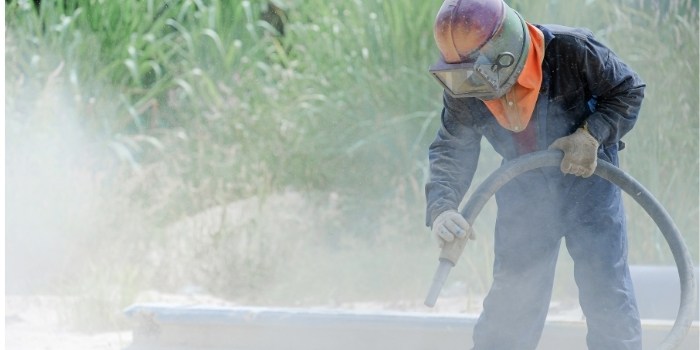
How Long Does It Take to Sandblast a Car Body?
Depending on the condition of the surface, the process to sandblast a car completely will take approximately two to three days of work.
Remember that this timeline can increase or decrease depending on the amount of surface that needs blasting.
Sandblasting a truck or an SUV will therefore usually take longer than the time needed to sandblast a smaller sedan body.
If you need to remove the paint or rust without sandblasting, there are other substitutes like paint strippers, acids, heat methods, and laser cleaning available that can get the job done.
Depending on the condition, you can also use household products like baking soda or vinegar for removing the peeling paint without sandblasting.
How Much Does It Cost to Get Your Car Sandblasted?
Generally, the cost of getting your car sandblasted will range between $100 and $1500.
The price will certainly depend on the surface area you are targeting and the amount of media that will be needed during the process to cover the entire area.
For example, if it’s only the dashboard you can get it done within $100. But if you need to get the doors, and hood sandblasted they can cost an additional $125 to $150 each.
Sandblasting the car frame can cost around $350 and sand blasting a car shell can go as high as $1200 to $1500.
The cost of sandblasting a car will also depend on…
- condition of the surface
- your luxury car brand and its age
- time spent on the job and its complexity level
Soda Blasting vs. Sandblasting for Auto Body: What’s the Difference?
Sandblasting can swiftly and expeditiously remove rust, paint, and oxidation residue from cars.
It can also be used to enhance surface quality by removing scratches or casting markings. And has been commonly used as a cleaning procedure for cars for over a century.
Soda blasting, on the other hand, uses baking soda particles, making it gentle on surfaces. It effectively removes paint, grease, and grime without damaging metal, making it ideal for car bodies and delicate parts.
But if you mistake it with soda blasting, let me tell you that there are differences between sandblasting and soda blasting that extend beyond their respective uses and materials.
- Soda blasting is appropriate for jobs where sandblasting may cause harm.
- Soda blasting may be used on many of the same surfaces, and for many of the same objectives.
- Soda blasting is non-hazardous to the environment and biodegradable, as it is less aggressive and also does not generate excessive heat.
So, for many auto body work, soda blasting is the safer choice. It cleans thoroughly while preserving the metal’s integrity, reducing the risk of dents or warping.
Sandblasting is better suited for heavy-duty restoration or very thick, rusted metal. It’s often used to strip out a rusty surface and old paint considerably faster than soda blasting.
But keep in mind that, as far as the cost goes, soda blasting costs more than sandblasting, as it is an environmentally friendly method. And also, it takes more time, which isn’t ideal for industrial purposes.
Final Thoughts
When it comes to abrasive blasting on steel or iron vehicle bodies, aluminum oxide stands out as one of the best choices for removing rust and stripping paint down to bare metal. This prepares the surface perfectly for a fresh coat of paint, ensuring a smooth, long-lasting finish.
But if safety is your priority, it’s better to use plastic media, which is gentler and reduces the risk of damage or injury.
We’ve explored different blasting media and compared them with gentler options like soda blasting to help you choose the right approach for your auto restoration or repainting project.
Hopefully, you found this guide useful! If it helped you make sense of sandblasting options, don’t forget to share it—your support helps us create more practical, in-depth content for car enthusiasts like you.

Based in Orem (Utah) John Paterson graduated from Utah Valley University and has begun writing in 2009. He has a large wealth of experience in writing articles related to cars, automotive repair, wheels, cleaning/maintenance, and much more. He has also written instructional articles in a similar niche for a few online publications as well. Currently, he works as a mechanic in his personal garage shop where he loves serving his countrymen from his heart.

